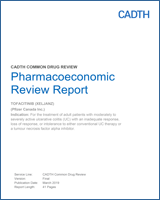Tofacitinib (Xeljanz) is an orally administered Janus kinase inhibitor indicated for the treatment of patients with moderately to severely active ulcerative colitis (UC) who have had an inadequate response, loss of response, or intolerance to either conventional UC therapy or a biologic agent. The recommended dosage for tofacitinib is one 10 mg tablet administered twice daily during an induction period lasting at least eight weeks, followed by one 5 mg tablet administered twice daily thereafter during the maintenance phase of treatment once response to treatment has been achieved. Tofacitinib 10 mg twice daily in the maintenance phase may be prescribed to some patients. The product monograph states that tofacitinib should be discontinued if no evidence of benefit is achieved by week 16. At the manufacturer-submitted price of $23.96 per 5 mg tablet and $42.34 per 10 mg tablet, the annual cost of tofacitinib is $19,501 in the first year and $17,442 every year thereafter, based on the recommended dosage for induction and 5 mg twice daily in the maintenance phase. This cost could increase significantly, up to $30,181 per year, in certain populations requiring tofacitinib 10 mg twice daily in the maintenance phase.
Tofacitinib 5 mg was previously considered by CADTH Canadian Drug Expert Committee for the treatment of rheumatoid arthritis in 2015 and was recommended to be listed with clinical criteria, with the condition that the drug plan cost for tofacitinib not exceed the drug plan costs for the biologic disease-modifying antirheumatic drugs.
The manufacturer submitted a cost-utility analysis comparing tofacitinib plus conventional therapy (a mix of 5-aminosalicylates, corticosteroids, and immunomodulators) with biologic treatments (vedolizumab, infliximab, infliximab biosimilar, adalimumab, and golimumab) plus conventional therapy (same as tofacitinib), as well as continuing conventional therapy (the same mix of 5-aminosalicylates, steroids, and immunomodulators) in patients (≥ 18 years of age) with moderately to severely active UC and an inadequate response to conventional therapy or biological agents. The analysis was conducted over a lifetime time horizon from a Canadian public health care payer perspective. The manufacturer submitted a cohort-level state-transition (Markov) model, in which patients entered the model in an active UC state and started an eight-week induction period with tofacitinib or a biologic comparator plus conventional therapy or continued on conventional therapy alone. At any time in the model, patients could experience a response or clinical remission, or remain in an active UC state (nonresponders), and patients in a clinical remission or response state could lose their response and regress to active UC. Patients in the active UC state could undergo a colectomy at any point; the risk of colectomy differed based on time since UC diagnosis.
Funding: CADTH receives funding from Canada’s federal, provincial, and territorial governments, with the exception of Quebec.
Disclaimer: The information in this document is intended to help Canadian health care decision-makers, health care professionals, health systems leaders, and policy-makers make well-informed decisions and thereby improve the quality of health care services. While patients and others may access this document, the document is made available for informational purposes only and no representations or warranties are made with respect to its fitness for any particular purpose. The information in this document should not be used as a substitute for professional medical advice or as a substitute for the application of clinical judgment in respect of the care of a particular patient or other professional judgment in any decision-making process. The Canadian Agency for Drugs and Technologies in Health (CADTH) does not endorse any information, drugs, therapies, treatments, products, processes, or services.
While care has been taken to ensure that the information prepared by CADTH in this document is accurate, complete, and up-to-date as at the applicable date the material was first published by CADTH, CADTH does not make any guarantees to that effect. CADTH does not guarantee and is not responsible for the quality, currency, propriety, accuracy, or reasonableness of any statements, information, or conclusions contained in any third-party materials used in preparing this document. The views and opinions of third parties published in this document do not necessarily state or reflect those of CADTH.
CADTH is not responsible for any errors, omissions, injury, loss, or damage arising from or relating to the use (or misuse) of any information, statements, or conclusions contained in or implied by the contents of this document or any of the source materials.
This document may contain links to third-party websites. CADTH does not have control over the content of such sites. Use of third-party sites is governed by the third-party website owners’ own terms and conditions set out for such sites. CADTH does not make any guarantee with respect to any information contained on such third-party sites and CADTH is not responsible for any injury, loss, or damage suffered as a result of using such third-party sites. CADTH has no responsibility for the collection, use, and disclosure of personal information by third-party sites.
Subject to the aforementioned limitations, the views expressed herein are those of CADTH and do not necessarily represent the views of Canada’s federal, provincial, or territorial governments or any third party supplier of information.
This document is prepared and intended for use in the context of the Canadian health care system. The use of this document outside of Canada is done so at the user’s own risk.
This disclaimer and any questions or matters of any nature arising from or relating to the content or use (or misuse) of this document will be governed by and interpreted in accordance with the laws of the Province of Ontario and the laws of Canada applicable therein, and all proceedings shall be subject to the exclusive jurisdiction of the courts of the Province of Ontario, Canada.
About CADTH: CADTH is an independent, not-for-profit organization responsible for providing Canada’s health care decision-makers with objective evidence to help make informed decisions about the optimal use of drugs, medical devices, diagnostics, and procedures in our health care system.

